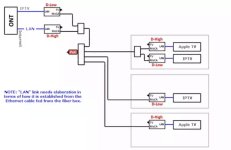Hi, two ECB7250 connecting two rooms work fine, LAN is 192.168.1.x; I want to use two more ECB7250, each pair connected via splitter, so two MoCA on a splitter in room A, and two MoCA on a splitter in room B.
BUT, each MoCA in room A is connected to a different LAN (192.168.1.x & 192.168.2.x), and MoCA in room B are feeding each one a different switch. In room B, some devices will be on 1.x (first switch) and some on 2.x (second switch). This setup is working erraticaly: sometimes on of the DHCP is giving IPs on the 1.x part, sometimes 2.x; forcing manual IPs isn't working. Some devices are Internet connected, some not.
So I was looking at a way to "separate" the two connections, with MoCA1 in room A communicating with MoCA1 in room B, but with a Netwok Security Setup (same PwD on both, in the D-Ext Band) switched ON on both MoCA1. The other two MoCA are NOT Security Enabled. The two MoCA1 with Security Enabled can't communicate, while the other two are OK. People at SceenBeam can't help me...
Any suggestion how to do it, if it's possible?
Thanks!
BUT, each MoCA in room A is connected to a different LAN (192.168.1.x & 192.168.2.x), and MoCA in room B are feeding each one a different switch. In room B, some devices will be on 1.x (first switch) and some on 2.x (second switch). This setup is working erraticaly: sometimes on of the DHCP is giving IPs on the 1.x part, sometimes 2.x; forcing manual IPs isn't working. Some devices are Internet connected, some not.
So I was looking at a way to "separate" the two connections, with MoCA1 in room A communicating with MoCA1 in room B, but with a Netwok Security Setup (same PwD on both, in the D-Ext Band) switched ON on both MoCA1. The other two MoCA are NOT Security Enabled. The two MoCA1 with Security Enabled can't communicate, while the other two are OK. People at SceenBeam can't help me...
Any suggestion how to do it, if it's possible?
Thanks!


